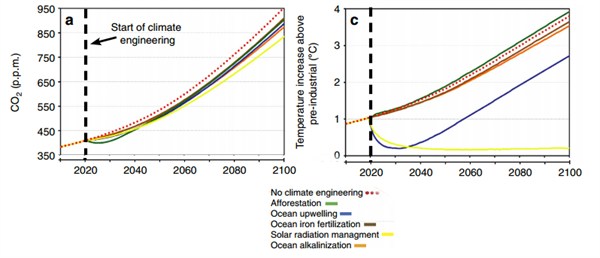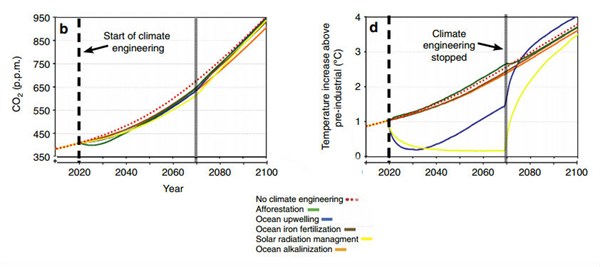Mat Hope
25.02.2014 | 4:00pmFrom dumping iron filings in the ocean to spraying artificial clouds, scientists are starting to consider some unconventional ways to tackle climate change. Some policymakers hope these techniques could one day make up for failing to significantly reduce greenhouse gas emissions now. But climate engineering’s side effects make it a risky fallback plan, new research suggests.
Even if climate engineering was rolled out immediately, it would be an “ineffective” way to tackle climate change, according to a new paper published in Nature Communications today.
Researchers from the Helmholtz Centre for Ocean Research in Germany modelled how a range of climate engineering techniques could constrain global warming over the coming decades. Thier results suggest the dangers that come with climate engineering could outweigh its benefits.
Climate engineering techniques
Climate engineering techniques can be broadly separated into two categories. Carbon dioxide reduction methods adjust planetary conditions so more of the gas can be absorbed from the atmosphere, while solar radiation management techniques seek to reduce how much the sun warms the planet.
Most climate engineering techniques work in theory, but none have been tried on a large scale.
The Helmholtz Centre researchers look at five techniques in particular:
- Afforestation, which involves irrigating deserts to allow vegetation to grow and absorb carbon dioxide.
- Ocean upwelling, where long pipes pump cold, nutrient-rich water from the deep ocean to the surface – effectively swapping the ocean’s top and bottom layers – where it absorbs carbon dioxide directly from the atmosphere and stimulates plants to grow and take up more carbon dioxide.
- Ocean alkalinisation, where lime is added to the ocean to alter its chemistry and increase its capacity to absorb carbon dioxide.
- Ocean iron fertilisation, where iron filings are put in the ocean to increase plant growth which absorbs more carbon dioxide from the atmosphere.
- Solar radiation management, which involves reducing the amount of sunlight that hits the earth’s surface.
The study assumes all of these technologies will be available soon, and deliberately overlooks any social, economic, or political obstacles that could stymie progress – essentially testing what would happen in a climate engineering best case scenario.
Climate impacts
Climate engineering would be a poor substitute for failing to reduce emissions now, the research suggests. The model’s results show most climate engineering techniques are unlikely to be able to keep warming below the internationally agreed target of two degrees above pre-industrial levels.
The graphs below show the impact the techniques could have on carbon dioxide concentrations and temperatures if they’re rolled out quickly and widely.
The left graph shows all the techniques could have an small impact on how much carbon dioxide is in the atmosphere, compared to a scenario in which there was no climate engineering (the red dotted line). The effect is likely to be pretty small, however.
 Without any climate engineering, the model estimates around 3.8 degrees of warming above pre-industrial levels by 2100 if emissions stay high over the coming decades. With a wide rollout of carbon dioxide reduction methods (all the techniques excluding solar radiation management), it estimates a temperature increase of between 2.7 and 3.9 degrees.
Without any climate engineering, the model estimates around 3.8 degrees of warming above pre-industrial levels by 2100 if emissions stay high over the coming decades. With a wide rollout of carbon dioxide reduction methods (all the techniques excluding solar radiation management), it estimates a temperature increase of between 2.7 and 3.9 degrees.
Solar radiation management (the yellow line) is the only technique that could restore temperatures to near pre-industrial levels before 2100, according to the model.
As such, the researchers say the impact of engineering the climate in the future is “very limited” in the absence of efforts to reduce emissions today.
Side effects
Even if climate engineering does have a small positive impact on emissions and temperatures, there are dangers involved with rolling out climate engineering on a large scale.
In particular, once climate engineering is started, stopping it could cause rapid climate change, the researchers warn.
This is a particular problem with the two techniques that could do the most to curb warming – solar radiation management and ocean upwelling. The graphs below show what could happen if climate engineering was started immediately, and abruptly halted in 2070.
If solar radiation management were stopped, emissions and temperatures could rise to the same level they would have anyway – meaning a jump of around 3.5 degrees in 30 years. If ocean upwelling were halted (the blue line), it could get even warmer – with temperatures rising beyond the level they otherwise would have by 2100.
That’s because the technique alters the salt and temperature layers in the ocean as well as circulation patterns, causing the earth to take up additional heat and store it below the surface of the ocean. That means if ocean upwelling were stopped, the heat would be released back into the atmosphere, causing the temperature to rise rapidly, the researchers warn.
It’s not just temperatures climate engineering can alter. There are a number of other side effects that need to be considered, the researchers say.
For instance, some solar radiation management techniques rely on spraying aerosols into the atmosphere that could deplete the ozone layer, while ocean alkalinisation can alter the amount of oxygen in the ocean – upsetting its ecosystems. Likewise, afforestation can reduce the salt content of coastal waters, with consequences for marine life and ocean currents.
So not only is climate engineering potentially ineffective, it could also lock the world into manipulating fragile ecosystems – with some pretty nasty impacts if it were ever stopped.
Feasibility
The Helmholtz Centre’s modelling assumes climate engineering will become technologically possible and socially acceptable pretty much straight away. Even in such favourable conditions – which don’t currently look likely – the researchers conclude that climate engineering is a poor substitute for taking immediate action to reduce emissions.
As such, taking climate action now seems to be a safer strategy than counting on technological fixes down the line, sidestepping the ecological dangers they bring.


